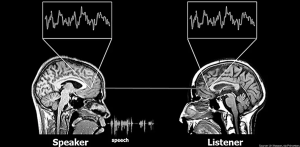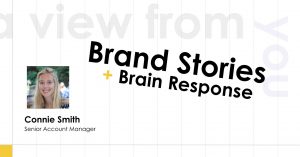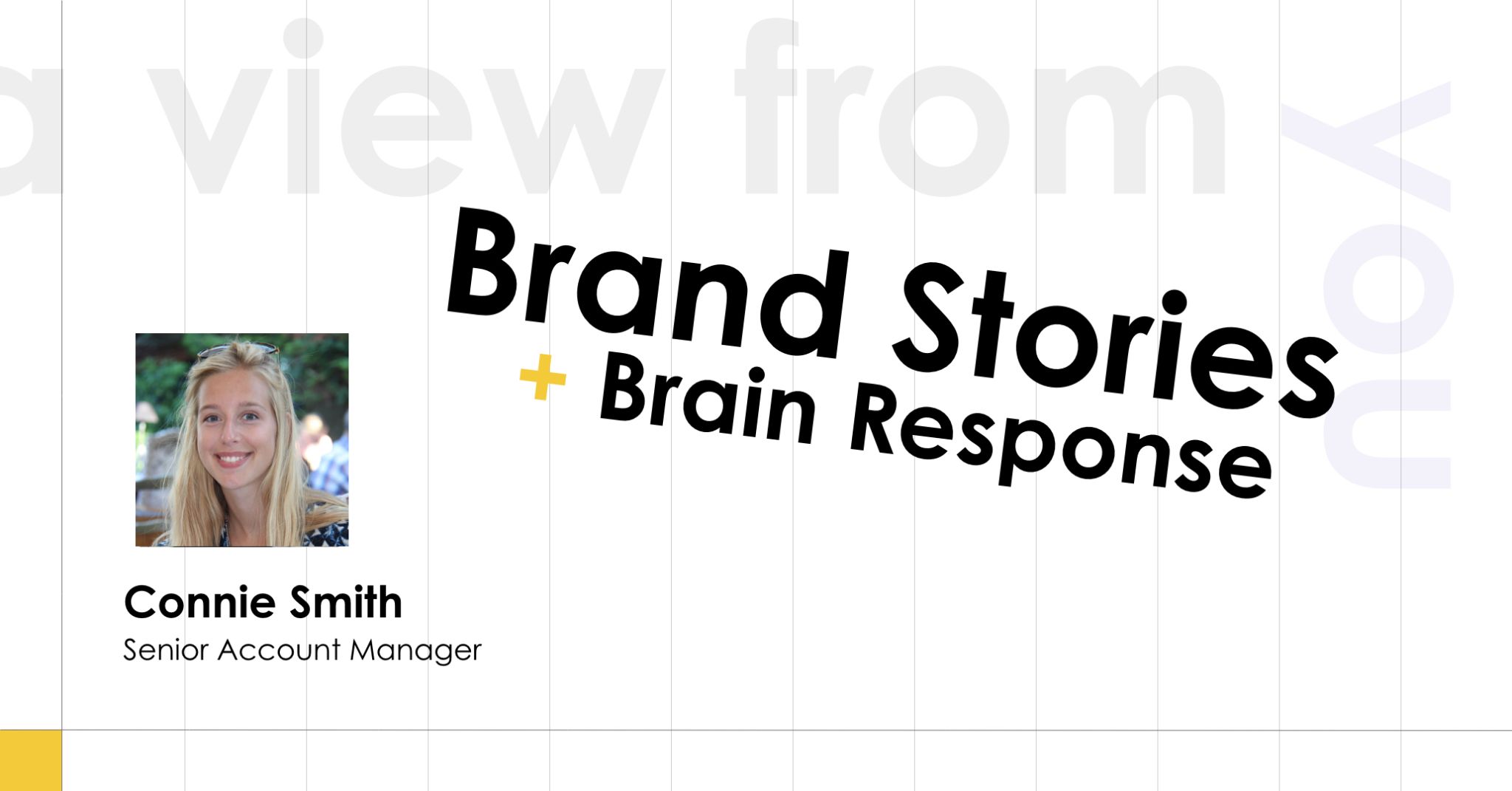Brand Stories + Brain Response
A View from Connie Smith:
It’s no secret that emotional connections drive brand success and good brand storytelling is pivotal to this. Stories have always been at the core of human experiences, shaping our identities and helping us to communicate our understanding of the world around us. When told effectively, stories can inspire loyalty, change habits and ignite social causes. But why do they work so well?
Last week, mobile phones across the UK buzzed as we were notified with of a grim statistic. The news that we’d reached a COVID death toll of 100,000. A shocking figure, which left most of us despondent, but it was just that, a figure. In stark contrast, over the weekend, the BBC aired interviews with families who have lost loved ones; heart-wrenching stories of final goodbyes over Facetime and parents having to bury their children. One woman spoke of the empty space in the bed when she reached over out of habit, expecting to find her husband. It’s safe to say, these moving accounts left many of us sobbing through the sports segment.
But why can stories invoke such a visceral emotional response whilst data, no matter how shocking, fails to cut through without being framed in the context of a story? The answer, neural coupling.
What is neural coupling?
Neural coupling is when the neurons firing in the brain of someone listening to a story begin mirroring those firing in the brain of the storyteller.1
It’s not just auditory stimulation in both individuals. When told the story in Russian, no neural coupling is detected.1 This is a true convergence of brain activity between speaker and listener which is routed in understanding, empathy and sharing a ‘lived’ experience.
Brain imaging studies have revealed that when presented with facts and data only the Broca and Wernicke’s areas (small regions of the brain associated with producing and understanding speech) are activated, but when we listen to stories all four brain lobes light up.1 These are linked to things like movement, smell, taste, hearing, vision and touch. Our brains respond to the events of a story as if they’re actually happening to us.
Compelling stories bring us on the journey. They engage listeners emotionally and command attention through emotional connection and empathy.2

Empathy, Oxytocin and Trust
What’s even more exciting, is that studies show that empathy may garner increased trust in the storytelling source.
Empathy leads to the release of oxytocin in your brain, sometimes referred to as the ‘cuddle hormone’ and typically linked to warm, fuzzy feelings – it’s also linked to lots of prosocial behaviours and one of those is trust. 3 4 5
Karen Eber talked about this in her recent TED talk, stating ‘The more empathy you experience, the more oxytocin is released in your brain. The more oxytocin you have, the more trustworthy you actually view the speaker.’ Eber concludes that the world’s best leaders earn trust and invoke action. 6 They don’t just present data – they also tell great stories. But the brain’s response to stories isn’t limited to visionaries inspiring a crowd.
What are the implications for brands?
Brands can harness the power of storytelling to create empathy by developing a robust brand story and finding compelling ways to tell it through meaningful campaigns – the ‘chapters’ of your brand’s story. There are a number of advertisers who have been successfully storytelling in their campaigns for years, like Dove, Nike and Apple, as well as some recent newcomers to the table.
Take Iceland’s advert with Greenpeace in 2018 about the girl with a ‘Rang-tan’ in her bedroom. It didn’t make it past Clearcast but did make it onto 30 million peoples’ screens online. It’s an excellent example of how a well-told story can spark neural coupling, creating empathy and encouraging action. Over 800,000 people signed Greenpeace’s petition.
When a brand tells a compelling story which makes you laugh, or cry… not only has an emotional connection been forged, but trust in the brand has been elicited.
This triple-whammy of trust, empathy and emotional connection is a powerful foundation on which to build fierce brand loyalty.
A new era for storytelling.
Through digital innovation, we’re in a new era in storytelling. Increasingly immersive technologies such as augmented reality (AR), virtual reality (VR) and 360-degree video are changing our ability to communicate due to the unique ability to inherently merge the roles of the listener and the storyteller. Whilst the ingredients that make stories resonate aren’t likely to change, if brands are to capitalise on this opportunity they must understand how and when to weave digital reality content into their marketing mix.
National Geographic has employed VR to drive its brand storytelling of exploring the natural world through a series of immersive travel experiences. For example, people can now learn about the struggles of growing up as a young male lion, while they’re sitting in his den!

Compared to traditional media, stories told using augmented and virtual reality are often considered more credible and result in more powerful emotional customer reactions. This represents a huge opportunity in 2021 for brands to be early adopters of this form of storytelling and attract new customers, whilst reinvigorating their relationships with existing ones.
Where do compelling stories come from?
At YOU Agency, we invest time and effort in customer research and market analysis to select the right stories for our clients to tell. Furthermore, we make sure the role a brand plays in a story is aligned with its strategic objectives. Without this due diligence, brands run the risk of their advertising being unoriginal, off-putting and potentially damaging. Regardless of the storyline, brands should always aim to be credible and to gain customer trust and buy-in.
There are limitless stories to tell and one of the first steps in selecting a shortlist is to establish what your customers care about and which stories and mediums are most likely to drive empathy, trust and your desired actions. The expanding potential of storytelling for brands cannot be understated.
In summary
- Compelling stories create empathy (demonstrated through neural coupling in the brain) which leads to emotional connection, trust and behaviour change.
- Brands can harness this to their advantage to cut through the noise, command attention, encourage brand trust and establish a solid foundation on which fierce brand loyalty can be built.
- Use digital tools such as AR, VR and 360-degree video to differentiate from competitors and create a deeper customer relationships and loyalty.
- Establish the most compelling stories through research and proposition testing involving real customers.
Sources
- Stephens G, Silbert L, Hasson U. Speaker-listener neural coupling underlies successful communication. Proceedings of the National Academy of Sciences. 2010;107(32):14425-14430. doi:10.1073/pnas.1008662107
- Why Storytelling Works: The Science | Ariel Group. Ariel Group. https://www.arielgroup.com/why-storytelling-works-the-science/. Published 2017. Accessed January 30, 2021.
- Procyshyn T, Watson N, Crespi B. Experimental empathy induction promotes oxytocin increases and testosterone decreases. Horm Behav. 2020;117:104607. doi:10.1016/j.yhbeh.2019.104607
- Kosfeld M, Heinrichs M, Zak P, Fischbacher U, Fehr E. Oxytocin increases trust in humans. Nature. 2005;435(7042):673-676. doi:10.1038/nature03701Kosfeld M, Heinrichs M, Zak P, Fischbacher U, Fehr E. Oxytocin increases trust in humans. Nature. 2005;435(7042):673-676. doi:10.1038/nature03701
- Xu L, Becker B, Kendrick K. Oxytocin Facilitates Social Learning by Promoting Conformity to Trusted Individuals. Front Neurosci. 2019;13. doi:10.3389/fnins.2019.00056
- Eber K. How your brain responds to stories — and why they’re crucial for leaders. Ted.com. https://www.ted.com/talks/karen_eber_how_your_brain_responds_to_stories_and_why_they_re_crucial_for_leaders. Published 2021. Accessed January 30, 2021.


